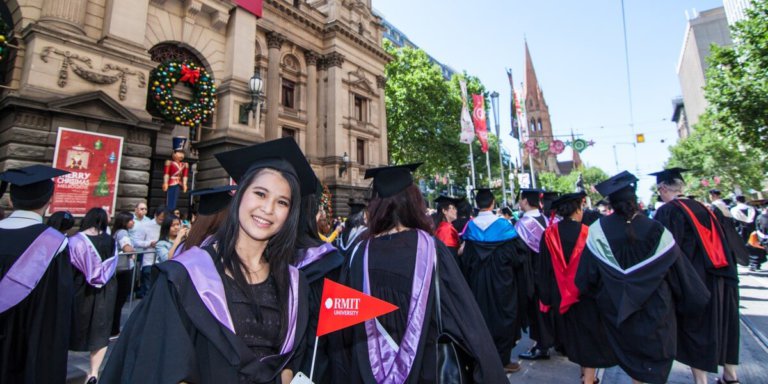
Half of all students enrolled in Master degree programmes in Australia are international students, according to the OECD’s latest annual report comparing global education outcomes.
According to The Age, “International students at Australian universities make up nearly half of all master’s enrolments and one-third of doctoral candidates, making the country’s higher-degree programs disproportionately dependent on the foreign market.
“International students make up 21 per cent of all tertiary enrolments in Australia, compared to an average of 6 per cent in other countries, according to the OECD’s latest annual report comparing educational outcomes around the world.”
Recently, there has been much debate over Australia’s heavy reliance on international students, to the point where universities have been lax about admissions and grant them special treatment when it comes to gaining acceptance.
While Australia has one of the highest international student populations in the world, foreign students make up only 14 percent of all enrolments in Bachelor degree programmes.
However, they make up 48 percent of all Master students and 32 percent of doctoral candidates. According to experts, this “will lead to a brain drain when these students return to their home countries”.
Why too many international students in Australia is a cause for concern
At most of Australia’s #universities, international students now account for more than 20% of total enrollment. #auspol https://t.co/vpHIisvzlp
— CIS (@CISOZ) September 9, 2019
A healthy number of international students in each country is a benefit; students are exposed to different cultures, the university community becomes more diverse and inclusive, and the economy gains strength.
However, brain drain is not the only problem when a country is too heavily reliant on a particular group of students.
Last month, adjunct scholar at the Centre for Independent Studies (CIS) and an associate professor at the University of Sydney Salvatore Babones released “the most definitive assessment of Australia’s international student industry ever conducted,” according to MacroBusiness.
The study revealed eye-opening data that showed that “Australia has roughly 2.5 times the number of international students per capita than second-placed United Kingdom, and three times the number per capita of third-placed Canada.”
Due to the findings, Babones said that because of the high concentration of international students in Australia, particularly Chinese students, entry and teaching standards are deteriorating.
According to the study, Australian universities are regularly comprising admissions standards to grant international students easier access.
Also, “Preparatory programs for students with lower English language test scores function as a paid work-around for international students who do not meet admissions standards.”
Not only does this bring the integrity and standards of a university into question, it’s also detrimental for international students.
Undertaking a degree programme without meeting the necessary English language requirements could lead to failure and low self-esteem, or at the very least, a miserable academic experience in which non-native students struggle to keep up with their peers.
The rising number of international students in Australia is a financial problem
#Australia: A #HigherEd regulator has found there are growing risks to the financial positions of providers, prompting a warning about heavy reliance on international students and other “emerging” vulnerabilities. https://t.co/8shG043FJp
— Grok Global (@grokglobal) July 18, 2019
From an economic point of view, the disproportionate number also places “universities at dire financial risk in the event that international student flows retrace.”
Babones wrote in his study, “Australia’s universities are taking a multi-billion dollar gamble with taxpayer money to pursue a high-risk, high-reward international growth strategy that may ultimately prove incompatible with their public service mission.
“Their revenues have boomed as they enrol record numbers of international students, particularly from China. As long as their bets on the international student market pay off, the universities’ gamble will look like a success. If their bets go sour, taxpayers may be called on to help pick up the tab.”
He also cautioned that the rising numbers of international students may stall, due to the reduction in China’s international student growth around the world.
“Chinese student numbers have flatlined since 2016, with the rapid growth in Chinese enrolments in Australia slowing dramatically in 2018 and now levelling off. It therefore seems safe to say that Australian universities may have reached ‘China max’, but is the current ‘China max’ actually safe?”
Chinese students’ misunderstanding of their host society thwarts their efforts to integrate in Australia, says academic https://t.co/VG6ckFcdtV pic.twitter.com/WIiR1pfNvA
— TimesHigherEducation (@timeshighered) September 8, 2019
The higher education sector in the US is already feeling the brunt of this, with an international student population, once strong and thriving, that is now decreasing due to visa issues under the Trump administration.
According to the Institute of International Education (IIE), international enrolments in the US decreased by 3 percent in 2016 and an additional 7 percent in 2017.
In light of this, Babones urges Australian universities to follow these four steps to “restore sanity in international student enrolments”.
Firstly, he advised to follow best practices in the US and UK, such as transparently reporting detailed student numbers by country, level and field of study.
Secondly, universities should “Make, publish, and implement plans to reduce their reliance on international students to manageable levels, with targets set both for the university as a whole and for individual programs.”
The third step should be to make, publish and implement plans to reduce the proportion of international students hailing from a particular country to manageable levels, and set targets both for the university and for individual programs.
The final step – last but definitely not least – is to “apply the same admissions standards to international students who pass through their income-generating preparatory programs as they do to students who apply for ordinary direct admission.”
Liked this? Then you’ll love…
Integration: How Australia’s public schools are failing – report
Growing concerns over foreign interference in Australian universities







